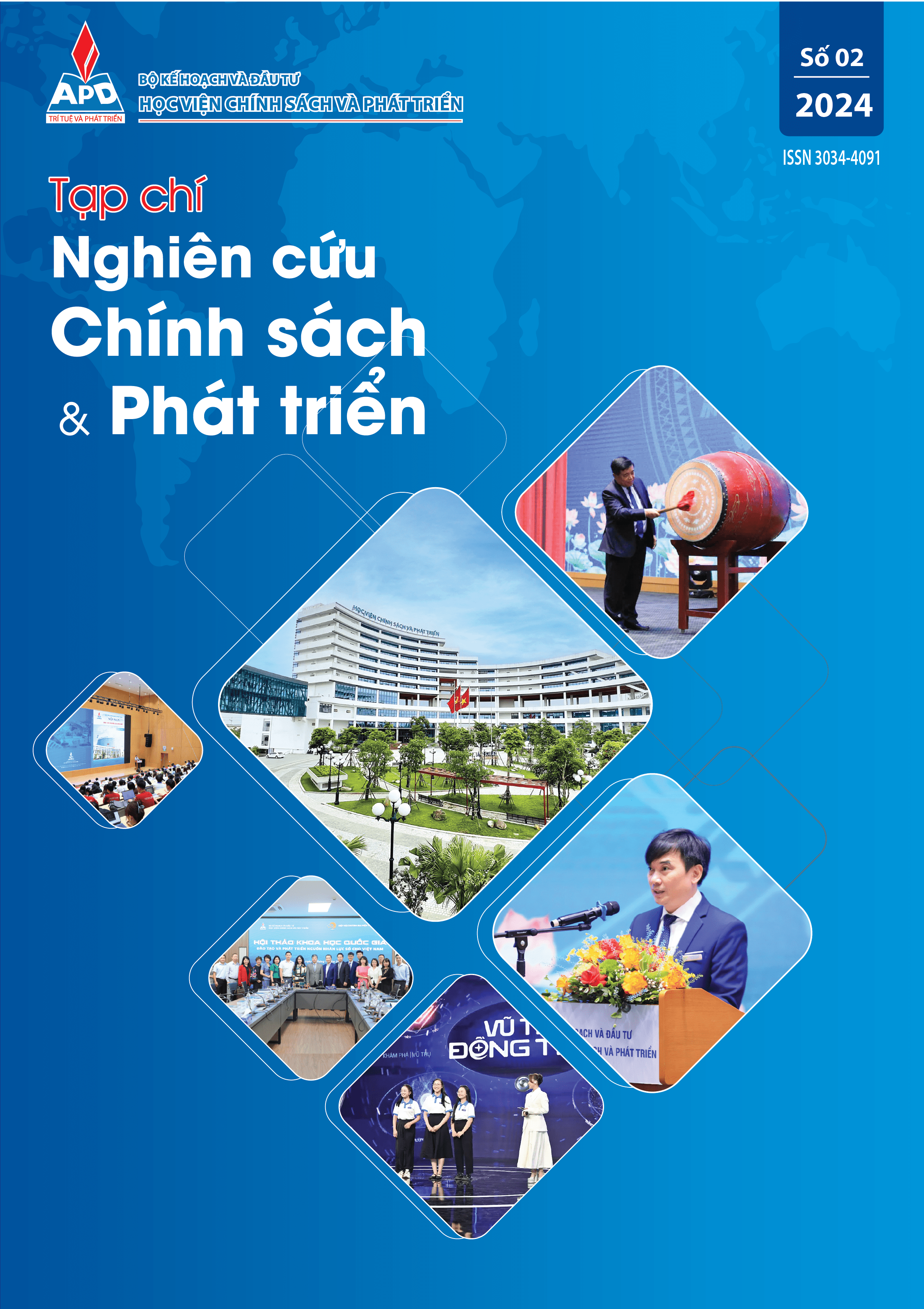Đổi mới sáng tạo và tăng trưởng kinh tế Kinh nghiệm của Trung Quốc và bài học cho Việt Nam
Downloads
Published
How to Cite
Issue
Section
Keywords:
economic growth, innovation, R&D, R&D expenditureAbstract
Economic growth in each country is driven by technological change, research and development (R&D), with R&D expenditure being a crucial indicator reflecting the level of innovation and creativity in these nations. In 2023, Vietnam was ranked 46th out of 132 countries in terms of innovation activities. However, Vietnam is still facing many difficulties and challenges, which are not commensurate with the intellectual potential and creative capacity of the Vietnamese people. This study aims to assess the impact of innovation on the economic growth of China, a country with many anthropological and cultural similarities to Vietnam. Through this assessment, we aim to draw some lessons for Vietnam as it strives to become a developed nation by 2045. The research data was collected from reliable sources such as the World Bank, OECD, and ILO over the period from 1991 to 2021.
References
1. Aghion, P. and Howitt, P. A. (1992), Model of Growth Through Creative Destruction, Econometrica, 60(2), 323-351.
2. Aghion, P., Bloom, N., Blundell, R., Griffith, R., Howitt, P. (2005). Competion and innovation: an inverted U relationship. Quarterly Journal of Economics, 120 (2), 701-728.
3. Aghion, P., Harmgart, H., Weisshaar, N. (2009). The causal impact of education on growth: evidence from US. Mimeo, Harvard University.
4. Bayarcelik, E.B. and Tasel, F. (2012), Research and Development: Source of Economic Growth. Social and Behavioral Sciences: 8th International Strategic Management Conference, Barcelona, Spain, June 21-23, 104-111.
5. Đàm, T. T. and Đàm, T. H. (2024). Innovation and economic growth - research from experimental models in developing countries and lessons learned for Vietnam. Proceeding of International conference Sustainable economic development: Opportunities and Challenges. Haiphong City, 442-454.
6. ILO (2024). Data catalogue. Retrieved from < https://ilostat.ilo.org/topics/youth/>.
7. Inglesi L., Chang, T. and Gupta, R. (2015), Causality Between Research Output and Economic Growth in BRICS. Quality & Quantity, 49(1), 167–176.
8. Nadiri, I. (1993). Innovations and Technological Spillovers. Working Paper 423- National Bureau of Economic Research. Cambridge, MA.
9. Ntuli, H., Inglesi, L., Chang, T., and Pouris, A. (2015), A. Does Research Output Cause Economic Growth or Vice Versa? Evidence from 34 OECD Countries, Journal of the Association for Information Science and Technology, 66(8), 1709-1716. https://doi.org/10.1002/asi.23285.
10. OECD (2020). Main Science and Technology Indicators. Retrieved from <https://dataexplorer.oecd.org/>.
11. OECD (2024), Gross domestic spending on R&D (indicator). https://doi.org/10.1787/d8b068b4-en
12. Pala, A. (2019), Innovation and Economic Growth in Developing Countries: Empirical Implication of Swamy’s Random Coefficient Model, 3rd World Conference on Technology, Innovation and Entrepreneurship (WOCTINE). https://doi.org/10.1016/j.procs.2019.09.252.
13. Pece, A. M., Simona, O. E., Salisteanu, F. (2015), Innovation and economic growth: An empirical analysis for CEE countries, 4th World Conference on Business, Economics and Management, WCBEM. Procedia Economics and Finance 26 (2015), 461 – 467.
14. Pessoa, A. (2007). Innovation and Economic Growth: What is the actual importance of R&D?. University of Porto, FEP Working Papers, No. 254, 1- 17.
15. Petrariu, I. R, Bumbac, R., Ciobanu, R. (2013). Innovation: a path to competitiveness and economic growth. The case of CEE countries, Theoretical and Applied Economics, 5(582), 15-26.
16. Romer, P.M. (1986). Increasing Returns and Long Run Growth, Journal of Political Economy, Vol. 98, 71-102
17. Romer, P.M. (1990). Endogenous Technological Change. Journal of Political Economy. 98(2), 337-367. 18. Schumpeter, J., A. (1939). Business Cycles: A Theoretical, Historical and Statistical Analysis of the Capitalist Process. Vol.1, McGraw-Hill, New York.
19. Solow, R. (1956). A Contribution to the Theory of Economic Growth, The Quarterly Journal of Economics. 70(1), 65-94.
20. Ulku, H. (2004). R&D, Innovation, and Economic Growth: An Empirical Analysis. International Monetary Fund Working Papers. WP/04/185, 2-35.
21. Westmore, B. (2013). R&D, Patenting and Growth: The Role of Public Policy. OECD Economics Department Working Papers. No. 1047, OECD Publishing, 2-48.
22. Westerlund, J. and D. Edgerton (2008). A Simple Test for Cointegration in Dependent Panels with Structural Breaks, Oxford Bulletin of Economics and Statistics, 70, 665-703.
23. WIPO (2023). Global Innovation Index 2023. Switzerland: ISBN: 978-92-805-3321-7. Retrieved from < https://www.wipo.int/global_innovation_index/en/202 3/>.
24. World Bank (2024). World Bank Open Data. Retrieved from < https://data.worldbank.org> Wong, K.P., Ho, Y.P., Autio, E. (2005). Entrepreneurship, Innovation and Economic Growth: Evidence from GEM data, Small Business Economics, 24(3), 335-350.
25. Xinhua (2023). China's spending on R&D hits 3 trln yuan in 2022. Retrieved from <https://english.www.gov.cn/archive/statistics/202301 /23/content_WS63ce3db8c6d0a757729e5fe5.html>







